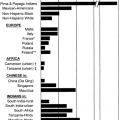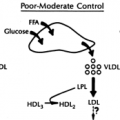Hypertension in Diabetes Mellitus
Samy I. McFarlane
Jonathan Castro
Dmitri Kirpichnikov
James R. Sowers
Hypertension is a very common comorbid condition in diabetes and accounts for up to 85% of excess cardiovascular disease (CVD) risk. Conversely, patients with hypertension are more prone to diabetes than are normotensive patients. Hypertension substantially increases the risk for coronary heart disease (CHD), stroke, retinopathy, and nephropathy. When hypertension coexists with diabetes, the risk of stroke or CVD is doubled and the risk for developing end-stage renal disease is increased five to six times compared with the risk for hypertensive patients without diabetes. In type 2 diabetes, hypertension usually clusters with the other components of the cardiometabolic syndrome, such as microalbuminuria, central obesity, insulin resistance, dyslipidemia, hypercoagulation, increased inflammation, left ventricular hypertrophy (LVH), and hyperuricemia. In type 1 diabetes, hypertension is usually a manifestation of diabetic nephropathy, and hypertension and nephropathy appear to exacerbate each other.
Hypertension in individuals with diabetes has characteristic features, including volume expansion, increased salt sensitivity, isolated systolic hypertension, loss of the nocturnal dipping of blood pressure and pulse, and increased propensity toward orthostatic hypotension and albuminuria.
To maximize the CVD risk reduction in this high-risk population, they should be treated with aspirin and have their low-density lipoprotein (LDL)-cholesterol lowered to less than 100 mg/dL and their blood pressure lowered to a target of 130/80 mm Hg. Combination of two or more drugs is usually necessary to achieve the target blood pressure of 130/80 mm Hg. Thiazide diuretics, angiotensin-converting enzyme (ACE) inhibitors and angiotensin-receptor (AR) blockers, β-blockers, and calcium-channel blockers are beneficial in reducing the incidence of CVD and stroke incidence in patients with diabetes.
RELATIONSHIP BETWEEN HYPERTENSION AND DIABETES
The major cause of mortality in patients with diabetes is CVD (1). Risk factors for CVD that cluster in diabetes (Table 57.1) include hypertension, central obesity, dyslipidemia, microalbuminuria, coagulation abnormalities, loss of nocturnal dipping of blood pressure and pulse, and LVH (2). Among those risk factors, hypertension is approximately twice as frequent in patients with diabetes as in those without diabetes and accounts for up to 85% of the CVD risk. Conversely, patients with hypertension are more prone to diabetes than are normotensive persons (2). In a large prospective study of 12,550 adults, type 2 diabetes was almost 2.5 times as likely to develop in patients with hypertension as in their normotensive counterparts after adjustment for age, sex, race, education, adiposity, family history with respect to diabetes, physical activity level, and other health-related behavior (3). The association between hypertension and insulin resistance, and the resultant hyperinsulinemia, is well established. In untreated patients with essential hypertension, fasting and postprandrial insulin levels were higher than in normotensive controls, regardless of the body mass index (BMI), with a direct correlation between plasma insulin concentrations and blood pressure. On the basis of these results, the authors concluded in this study that essential hypertension is an insulin-resistance state (4). Another study of 24 adults documented that patients with hypertension, whether treated or untreated, are insulin resistant, hyperglycemic, and hyperinsulinemic compared with a well-matched control group (5). Insulin resistance and hyperinsulinemia are also present in rats with genetic hypertension, such as Dahl hypertensive and spontaneously hypertensive rat strains (6,7). On the other hand,
the association of insulin resistance and essential hypertension does not occur in secondary hypertension (8). These data suggest a common genetic predisposition for essential hypertension and insulin resistance, a concept that is also supported by the finding of altered glucose metabolism in normotensive offspring of hypertensive patients (9,10).
the association of insulin resistance and essential hypertension does not occur in secondary hypertension (8). These data suggest a common genetic predisposition for essential hypertension and insulin resistance, a concept that is also supported by the finding of altered glucose metabolism in normotensive offspring of hypertensive patients (9,10).
TABLE 57.1. Metabolic Disorders Associated with Hypertension and Diabetes | ||||||||||||||||
|---|---|---|---|---|---|---|---|---|---|---|---|---|---|---|---|---|
|
HEMODYNAMIC AND METABOLIC CHARACTERISTICS OF HYPERTENSION IN DIABETES
Hypertension in patients with diabetes, compared with hypertension in those without diabetes, has unique features, such as increased salt sensitivity, volume expansion, loss of nocturnal dipping of blood pressure and pulse, increased propensity to proteinuria and orthostatic hypotension, and isolated systolic hypertension (2). Most of these features are considered risk factors for CVD (Table 57.1) and are particularly important for selecting the appropriate antihypertensive medication, for example, low-dose diuretics for treatment of volume expansion and ACE inhibitors or AR blockers for proteinuria.
Salt Sensitivity and Volume Expansion
Alterations in sodium balance and extracellular fluid volume have heterogeneous effects on blood pressure in both normotensive and hypertensive subjects (11). Increased salt intake does not raise blood pressure in all hypertensive subjects, and sensitivity to dietary salt intake is greatest in the elderly; those with diabetes, renal insufficiency, and low renin status; and African Americans (12,13). Studies demonstrated that salt sensitivity in normotensive subjects is associated with a greater age-related increase in blood pressure (14). This is particularly important to consider in the management of hypertension in patients with diabetes, especially elderly persons, since the prevalence of both diabetes and salt sensitivity increases with age. Thus, a decreased salt intake along with other aspects of diet such as reductions in fat and free carbohydrates and an increase in potassium are important to institute in these patients (2).
Loss of Nocturnal Decline in Blood Pressure
Normotensive individuals and most patients with hypertension have a reproducible circadian pattern to blood pressure and heart rate during 24-hour ambulatory monitoring (15). Typically, the blood pressure is highest while the patient is awake and lowest during sleep, a pattern called “dipping,” in which blood pressure decreases by 10% to 15%. Patients with loss of nocturnal decline in blood pressure, “non-dippers,” have a less than 10% decline in blood pressure during the night compared with their daytime blood pressure values (16). Patients with diabetes and many of those with the cardiometabolic syndrome have a loss of nocturnal dipping, as demonstrated by 24-hour ambulatory monitoring of blood pressure. This is particularly important since the loss of nocturnal dipping conveys excessive risk for stroke and myocardial infarction. In fact, ambulatory blood pressure has been reported to be superior to office blood pressure in predicting target-organ involvement such as LVH (17,18). About 30% of episodes of myocardial infarction and 50% of strokes occur between 6:00 a.m. and noon. This is particularly important in deciding strategies for the optimal dosing of antihypertensive medications, for which drugs that provide consistent and sustained 24-hour blood pressure control will be advantageous (19).
Microalbuminuria
There is considerable evidence that hypertension in type 1 diabetes is a consequence, rather than a cause, of renal disease and that nephropathy precedes the rise in blood pressure (20). Persistent hypertension in patients with type 1 diabetes is often a manifestation of diabetic nephropathy, as indicated by an elevation of urinary albumin at the diagnosis of the disease (20). Hypertension and nephropathy appear to exacerbate each other. In type 2 diabetes, microalbuminuria is associated with insulin resistance (21), salt sensitivity, loss of nocturnal dipping, and LVH (22). Elevated systolic blood pressure is a significant determining factor in the progression of microalbuminuria (23,24). Indeed, there is increasing evidence that microalbuminuria is an integral component of the metabolic syndrome associated with hypertension (21,22). This concept is important to consider in selecting pharmacologic therapy for hypertension in patients with diabetes, for which medications that decrease both proteinuria and blood pressure, such as ACE inhibitors and AR blockers, have evolved as increasingly important tools for reducing the progression of nephropathy. Further, aggressive blood pressure lowering, often requiring several drugs, is very important in controlling the progressive diabetic renal disease.
Isolated Systolic Hypertension
With the progression of atherosclerosis in patients with diabetes, the larger arteries lose elasticity and become rigid. The systolic blood pressure increases disproportionately because the arterial system is incapable of expansion for any given volume of blood ejected from the left ventricle, leading to isolated systolic hypertension, which is more common and occurs at a relatively younger age in patients with diabetes (2,25).
Orthostatic Hypotension
Pooling of blood in dependent veins when an individual rises from a recumbent position normally leads to a decrease in stroke volume and systolic blood pressure with concomitant increases
in systemic vascular resistance, diastolic blood pressure, and heart rate. In patients with diabetes and autonomic dysfunction, excessive venous pooling can cause immediate or delayed orthostatic hypotension that might cause a reduction in cerebral blood flow, leading to intermittent lightheadedness, fatigue, unsteady gait, and syncope (26,27,28). This is important to recognize in patients with diabetes and concomitant hypertension because it has several diagnostic and therapeutic implications; for example, discontinuation of diuretic therapy and volume repletion might be necessary for the treatment of chronic orthostasis. Also, in the subset of patients with “hyperadrenergic” orthostatic hypertension, as manifested by excessive sweating and palpitation, the use of low-dose clonidine might be necessary to blunt an excess sympathetic response (29). Furthermore, increased propensity for orthostatic hypertension in patients with diabetes renders β-adrenergic receptor blockers less desirable and second-line agents for these patients. In addition, doses of all antihypertensive agents must be titrated more carefully in patients with diabetes, who have greater propensity for orthostatic hypertension while having a high supine blood pressure.
in systemic vascular resistance, diastolic blood pressure, and heart rate. In patients with diabetes and autonomic dysfunction, excessive venous pooling can cause immediate or delayed orthostatic hypotension that might cause a reduction in cerebral blood flow, leading to intermittent lightheadedness, fatigue, unsteady gait, and syncope (26,27,28). This is important to recognize in patients with diabetes and concomitant hypertension because it has several diagnostic and therapeutic implications; for example, discontinuation of diuretic therapy and volume repletion might be necessary for the treatment of chronic orthostasis. Also, in the subset of patients with “hyperadrenergic” orthostatic hypertension, as manifested by excessive sweating and palpitation, the use of low-dose clonidine might be necessary to blunt an excess sympathetic response (29). Furthermore, increased propensity for orthostatic hypertension in patients with diabetes renders β-adrenergic receptor blockers less desirable and second-line agents for these patients. In addition, doses of all antihypertensive agents must be titrated more carefully in patients with diabetes, who have greater propensity for orthostatic hypertension while having a high supine blood pressure.
TARGET BLOOD-PRESSURE LEVELS IN PATIENTS WITH DIABETES
The Hypertension Optimal Treatment (HOT) (30) and the United Kingdom Prospective Diabetes Study (UKPDS) (31) demonstrated improved outcomes, particularly in preventing stroke, in patients assigned to lower blood pressure targets. In the HOT trial, improved outcomes were achieved in the group assigned to a target diastolic blood pressure of less than 80 mm Hg (30). Epidemiologic studies also suggest an increase in CVD events and mortality with a blood pressure of greater than 120/70 mm Hg, and a target blood pressure of less than 130/80 mm Hg is currently recommended by the Seventh Joint National Committee on Prevention, Detection, Evaluation, and Treatment of High Blood Pressure (JNC-VII) (32) and the American Diabetes Association (ADA) (33). The treatment algorithm (Fig. 57.1) reflects the new JNC-VII treatment goal of blood pressure less than 130/80 mm Hg as well as the latest recommendations regarding drug therapy and reflects the results
of the Antihypertensive and Lipid-Lowering Treatment to Prevent Heart Attack (ALLHAT) study (34,35).
of the Antihypertensive and Lipid-Lowering Treatment to Prevent Heart Attack (ALLHAT) study (34,35).
Stay updated, free articles. Join our Telegram channel

Full access? Get Clinical Tree








